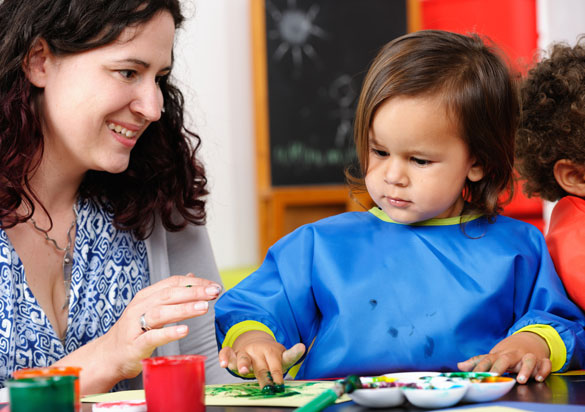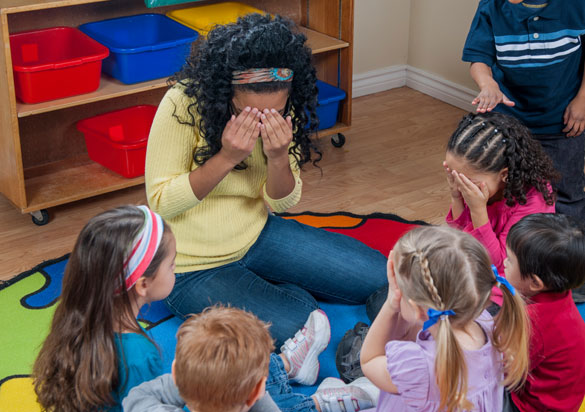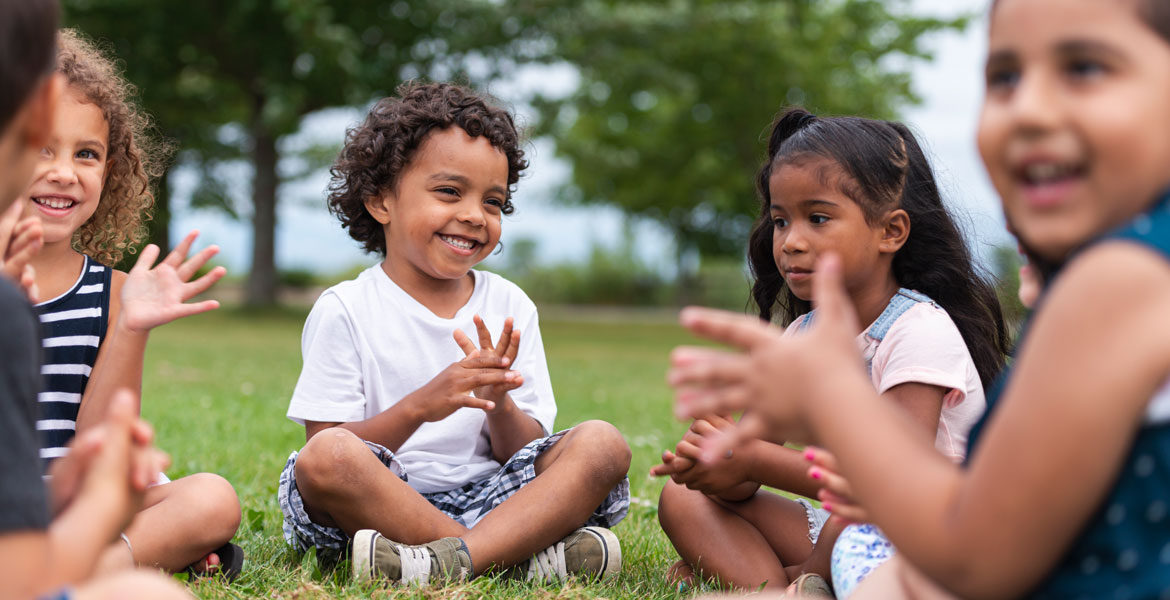

Playing is a critical part of the Transitional Kindergarten (TK) classroom. Play is so important for child development that it has been recognized as a human right by the United Nations.1 Contrary to some perceptions, play and learning are not exclusive—in fact, young children often learn better through play than through more traditional “desk work.” The National Association for the Education of Young Children (NAEYC) states that, “Play is an important vehicle for developing self-regulation as well as for promoting language, cognition, and social competence. [Play] gives [children] opportunities to develop physical competence and enjoyment of the outdoors, understand and make sense of their world, interact with others, express and control emotions, develop their symbolic and problem-solving abilities, and practice emerging skills.”2
Every one of these skills is developed through play!
Note: Retrieved from The Powerful Role of Play in Early Education (California Department of Education). Information sourced from Transitional Kindergarten Teachers at Elk Grove Unified School District and inspired by California’s Preschool Learning Foundations and Kindergarten State Standards.
As a teacher, you should incorporate many opportunities for free play, guided play, and teacher-directed play. Each type of play supports learning in a different way.
In free play, children get to choose their own activities and materials and decide the structure, meaning, and “rules” of the game or activity they are engaged in. Examples of free play include: “playing house” or other imaginative games, building structures with blocks, and playing on the slide during recess. During free play, the role of the teacher is to observe, listen to, document, and acknowledge children. The teacher observes the themes children explore in their play and further develop the play through additions to the environment and curriculum.

In guided play, the child chooses and directs the play activity, with an adult available to interact and offer support, increase engagement, or extend the development of skills and knowledge. This adult guidance is sometimes referred to as “scaffolding.” An example of guided play is a teacher noticing a group of students playing “restaurant” and using this cue to lead the group or the entire class in a more developed “restaurant” dramatic play and encouraging oral skills as students order food and numeracy skills by guiding students in “paying” for imaginary food and drinks. In another example, a teacher who notices children playing with snails at recess may bring books involving snails to the classroom, read a selected book at storytime, and lead the class in a discussion about snails.

As its name implies, adult-directed play is planned and directed by adults, with children expected to follow the adult-initiated rules and directions. For many teachers, this is the most intuitive form of play, as it feels the most like “teaching” in a traditional sense. However, this form of play should be limited and teachers should look for opportunities to step back and look for ways to achieve the goals desired in directed play through guided or free play. However, there are times when directed play can be an effective tool to help teach! Examples of adult-directed play include: games such as “red light, green light” or Letter Bingo to help build letter recognition skills.

Outdoor play is a lot more than just recess! In addition to allowing free play during recess, teachers should consider moving other parts of their school day outdoors if the environment and weather allow it. Being outdoors in nature has proven to have strong positive effects on mental health and is especially beneficial for children experiencing adversity and trauma, who may have limited or no outdoor play opportunities outside of school. Outdoor play innately encourages physical activity and helps develop lifelong healthy habits. In addition, outdoor play allows children to develop a connection with nature and curiosity about, knowledge of, and respect for other animals, insects, plants, and the environment.
Outdoor play also offers opportunities for “big body” or “rough and tumble” play—while many teachers may discourage rough and tumble play, it offers opportunities for children to develop critical physical, communication, and social-emotional skills. Contrary to popular opinion, “big body” play is no more likely to lead to fights or physical conflict than are other forms of play. Teachers can work to set reasonable rules (e.g., keep hands below the neck and above the waist) to allow children to engage in physically active play while helping them stay safe.
Teachers can organize spaces outdoors that allow for learning that traditionally takes place inside to move outdoors. Outdoor classrooms allow for more physically active activities and greater opportunities for child-directed learning. Some activities that teachers may do outdoors could include reading a book about leaves changing color in the fall, and then encouraging children to search for leaves in different colors and drawing and describing their leaves. If space allows, consider planting a class garden, even if you only have space for one or two planter boxes or pots. This activity can provide learning opportunities for many months as children learn to take responsibility for watering the garden, observe, and describe the changes in plants as they grow, capture, observe, and release insects and sample the final crop.
Teachers take their responsibility to care for and protect their students very seriously and with good reason. However, it is increasingly understood that children need some risk in their play in order to challenge themselves and learn important skills. Allowing a child to experience play that may involve falls, scrapes, bruises, or even (hopefully infrequently!) a broken bone helps children gain competencies that actually lead to a lesser risk of serious injury later in childhood. The connection between lack of risk in childhood play and later serious injuries is so great that a German insurance company requested schools and parks and recreations departments to increase the “risk” in play areas, indicating that focusing on safety exclusively had led to children having stunted risk assessment abilities and greater chances of serious injuries later in life.3 In addition, play areas that are designed with a strong eye for safety may increase the risk of accidents, as children utilize the equipment in ways that it is not intended in order to increase the challenge.
However, allowing children to take risks in play is not easy in modern society! The California Department of Education (CDE), in their document The Powerful Role of Play in Early Education, notes that “restrictive laws, extensive regulations, and fear of lawsuits have all contributed to the risk-averse culture in the U.S. Supporting children in having opportunities to participate in risky play and enjoy all the benefits associated with learning to take risks will require addressing the policies and regulations that fuel the current conditions.”4
Teachers can begin to safely incorporate risk by carefully observing children’s play to conduct their own risk assessment and assessing if the benefits of the chosen activity are worth the risk. To do this, teachers should consider the benefits of an activity and the risks involved. For example, climbing a tree may present children with opportunities to improve strength and balance, physical coordination, group cooperation, and a sense of enjoyment, accomplishment, and self-esteem. However, it also presents the risk that children may fall and suffer an injury. The teacher should assess if the tree is of a level of challenge that is appropriate for the children’s age and developmental level (this means the skills needed to climb the tree are within the children’s reach with practice, not that every child already possesses the skills needed to successfully climb the tree on the first time) and if the risks are acceptable (that a fall may result in bruises or scrapes, but has a low probability of greater injury). Children may be able to safely climb higher on a tree with grass underneath than a tree that overlooks concrete. Finally, the teacher may wish to consider if the tree can be best enjoyed if risks are mitigated—for example, by painting a line or tying a flag at the maximum height that children are permitted to climb. Risky situations that do not provide any benefit to children (for example, a loose piece of play equipment that can pinch or break fingers) should be corrected immediately.
Inclusive play is beneficial for all children, not just children with disabilities. By ensuring that all children can participate in play, children with disabilities gain the same opportunities to practice social-emotional, communication, and physical skills as their peers, while fostering empathy and an appreciation for diverse experiences and abilities in all children in the classroom. Teachers should use the principles of universal design in order to design spaces that can be accessed in multiple ways that support the diverse needs of the class.5 Examples of universal design are placing toys in bins that are not only color-coded but also each have a textural element on the box to help distinguish them both visually and tactilely. In the same way a typical child may remember that blocks can be found in the blue bin, a visually impaired child could search for the bin with furry fabric taped to the side. Teachers can also help support and guide students to help them include classmates with different needs—for example, suggest that a child in a wheelchair can be a truck driver or train engineer when engaging in imaginative play.

Our TK classroom shares the playground with an inclusive preschool program and we have one shared outside playtime together. During this time, there are additional trained adults on the playground to support the preschool children, including those with disabilities. The aides bring bubbles, chalk, and other playground equipment that my TK students do not usually have access to. During this shared playtime all the children are given free rein to play with whatever and whomever they like. The TK children often approach the children with disabilities to draw chalk with them, blow bubbles, or play catch. As a TK staff, we work to support these interactions in a very child-directed way. For example, the TK yard aide (the adult assigned to supervise the TK children during outdoor play) has noticed that all of the children benefit greatly from these joint playtimes. The preschool staff appreciates how the children create shared meaning through their joint play. The TK yard aide also appreciates the additional adults on the yard which helps to create more of a community feel for all of the children. She encouraged me as the TK teacher to work collaboratively with the preschool staff to explore how we can bring this collaborative play into our TK classroom and extend the children’s opportunities to experience an inclusive play culture with their peers.
—Sandall et al, 2019, as cited in The Powerful Role of Play in Early Education (California Department of Education, 2021).
Note: Except where otherwise cited, the information on this page was provided by The Powerful Role of Play in Early Education (California Department of Education, 2021).
| 1 | California Department of Education (2021). The Powerful Role of Play in Early Education. Sacramento, CA. www.cde.ca.gov/sp/cd/re/documents/powerfulroleofplay.pdf |
| 2 | Pizzolongo, P & Snow, K. (N.D.) A Conversation About Play. National Association for the Education of Young Children. www.naeyc.org/resources/pubs/books/spotlight-young-children-exploring-play-a-conversation-about-play |
| 3 | Skenazy, L. (Nov. 1, 2021). German Insurance Companies Demand Perilous Playgrounds so that Kids can Learn About Risk. Reason magazine. https://reason.com/2021/11/01/germany-playgrounds-risk-insurance-fall/ |
| 4 | California Department of Education (2021). The Powerful Role of Play in Early Education. Sacramento, CA. www.cde.ca.gov/sp/cd/re/documents/powerfulroleofplay.pdf |
| 5 | ibid |